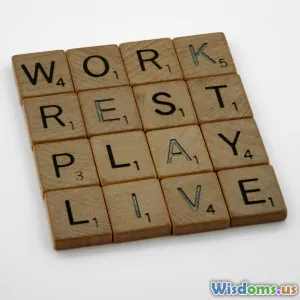
From Setback to Comeback Lessons in Staying Motivated When Life Hits Hard
8 min read Explore powerful lessons to reignite motivation and transform setbacks into inspiring comebacks. (0 Reviews)
From Setback to Comeback: Lessons in Staying Motivated When Life Hits Hard
Life has a way of knocking us down at the most unexpected times. Whether it’s losing a job, dealing with illness, facing personal failures, or enduring the loss of a loved one, setbacks can be devastating. But far from being final, setbacks offer invaluable opportunities for growth, reflection, and forging a powerful comeback. What separates those who remain stuck from those who bounce back is motivation — that persistent inner fire that propels us forward even when the path is murky.
In this article, we’ll dive deep into the art and science of staying motivated when life hits hard. Backed by research, real-world examples, and the insights from experts, you’ll gain practical lessons to harness your resilience and transform obstacles into momentum.
Understanding Setbacks: Not the End, But the Beginning
Setbacks come in many shapes and sizes, and often they strike when least expected. Psychologists define setbacks as experiences that temporarily impede progress toward important goals (Carver & Scheier, 1998). Yet, understanding the nature of setbacks helps reshape our mindset from helplessness to empowerment.
Example: Thomas Edison famously said about his failed light bulb prototypes, "I haven't failed. I've just found 10,000 ways that won't work." His resilience amid repeated setbacks ultimately illuminated the world.
By reframing setbacks as learning opportunities, we trigger a psychological shift. The growth mindset — a concept popularized by Carol Dweck — encourages viewing challenges as chances to develop abilities rather than as insurmountable failures.
Building Motivation: The Fuel Behind the Comeback
1. Clarity of Purpose
Motivation thrives when powered by a clear purpose. When life hits hard, this clarity may blur, but reconnecting with your why can reignite your drive.
Insight: According to Viktor Frankl, a Holocaust survivor and psychologist, the primary human motivation is finding meaning even in suffering. His work "Man’s Search for Meaning" exemplifies how purpose enables motivation even in the direst circumstances.
2. Setting Small, Achievable Goals
Overwhelming challenges can crush motivation. Breaking down daunting tasks into manageable steps fosters a sense of progress.
Data: Research from Edwin Locke in goal-setting theory indicates that specific, challenging yet attainable goals boost performance and persistence.
Practical tip: If you lost your job, instead of fixating on immediately finding the perfect role, set incremental goals—update your resume, network with one person a day, apply to two jobs each week. Each small win rekindles confidence.
3. Leveraging Social Support
Human motivation flourishes within connection. Isolation during a setback can deepen despair, but support networks offer encouragement and accountability.
Example: Consider Olympic athletes who often credit their coaches, families, and communities for sustaining their motivation through injuries or defeats. Their success stories highlight the vital role of supportive relationships.
4. Practicing Self-Compassion
Harsh self-criticism drains motivation by fostering negative self-talk. Kristin Neff’s research reveals that self-compassion—treating yourself with kindness and understanding—buffers against anxiety and depression while enhancing motivation.
Exercise: When you experience a setback, pause and speak to yourself as a supportive friend would. This kindness fuels resilience needed for a comeback.
Real-World Comebacks: Lessons from Lives Rebuilt
J.K. Rowling: From Welfare to Wizardry
Before Harry Potter, Rowling faced multiple rejections and personal challenges, including single motherhood and financial hardship. Yet, her determination to tell her story fueled her comeback, illustrating how perseverance combined with unwavering belief in purpose defies setbacks.
Steve Jobs: The Return of a Visionary
Fired from Apple in 1985, Jobs could have succumbed to defeat. Instead, he founded Pixar and NeXT, ultimately returning to Apple to revolutionize technology. His comeback underscores the power of creative resilience and keeping passion alive.
Nick Vujicic: Thriving Without Limits
Born without limbs, Vujicic faced physical and emotional hardships. His story teaches that overcoming deeply personal setbacks requires cultivating intrinsic motivation to inspire others and live purposefully.
Strategies for Maintaining Motivation Through Tough Times
Embrace Adaptability
Setbacks often demand flexibility. When goals or plans become untenable, revising your approach creatively can preserve momentum.
Example: The 2020 pandemic forced many businesses to pivot online. Entrepreneurs who adapted quickly sustained their motivation by focusing on new opportunities amid adversity.
Mindfulness and Stress Management
Stress undermines motivation by impairing cognitive functions such as focus and decision-making. Mindfulness practices reduce stress and increase emotional regulation, enabling clearer thinking.
Studies show that even 10 minutes of daily mindfulness meditation improved resilience in high-stress occupations, from healthcare to education.
Visualization and Positive Affirmations
Visualizing success and using affirmations reinforce positive self-belief and motivate proactive behaviors. Athletes routinely employ mental imagery to prepare for competition, a tactic anyone can borrow when facing life’s hurdles.
Tracking Progress and Celebrating Wins
Regularly reviewing progress keeps motivation front and center. Incorporating celebrations of even modest achievements sustains morale and reminds you of your capacity to overcome.
Conclusion: The Transformative Power of the Comeback
Setbacks hurt — emotionally and sometimes physically — but they are not the final chapters of our stories. By combining clear purpose, strategic goal-setting, social support, self-compassion, and adaptability, we can stay motivated through turmoil.
Every comeback is unique, fueled by individual passion and resilience. What remains consistent is the human spirit’s incredible capacity to bounce back, learn, and thrive. As author C.S. Lewis noted, “Hardship often prepares an ordinary person for an extraordinary destiny.”
When life hits hard, choose not to surrender to defeat. Instead, harness motivation as your ally, transforming setback into comeback, despair into hope, and adversity into opportunity.
References
- Carver, C.S. & Scheier, M.F. (1998). On the Self-Regulation of Behavior. Cambridge University Press.
- Dweck, C. (2006). Mindset: The New Psychology of Success. Random House.
- Frankl, V. E. (1946). Man’s Search for Meaning. Beacon Press.
- Locke, E. A., & Latham, G. P. (2002). Building a practically useful theory of goal setting and task motivation. American Psychologist.
- Neff, K. D. (2011). Self-Compassion. HarperCollins.
Embrace your journey from setback to comeback and emerge stronger than ever.
Rate the Post
User Reviews
Popular Posts




















